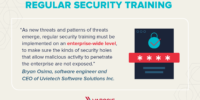In the digital age, securing sensitive information is paramount. From personal data to confidential business records, protecting data is not just a legal requirement but an ethical obligation. In this article, we’ll explore rapid tips for data defense, helping you establish robust security practices to safeguard sensitive information from unauthorized access and potential breaches.
1. Conduct Regular Data Audits
Start by understanding what data you have and where it resides. Conduct regular data audits to identify and classify sensitive information. Knowing the types of data you possess allows you to implement targeted security measures based on the criticality and sensitivity of each data category.
2. Implement Access Controls
Enforce strict access controls to ensure that only authorized individuals have access to sensitive data. Use role-based access control (RBAC) to assign permissions based on job responsibilities. Regularly review and update access privileges to align with personnel changes and evolving business needs.
3. Encrypt Data at Rest and in Transit
Utilize encryption to protect data both at rest and in transit. Encrypting data at rest involves securing information stored on servers, databases, or other storage devices. Encrypting data in transit involves securing data as it travels across networks. Implementing encryption adds an additional layer of defense against unauthorized access.
4. Secure Your Physical Environment
Physical security is as crucial as digital security. Ensure that servers, data centers, and any physical storage locations are secure. Control access to these areas, use surveillance measures, and implement environmental controls to safeguard against physical threats such as theft, vandalism, or natural disasters.
5. Regularly Update and Patch Systems
Keep software, operating systems, and applications up to date by applying security patches promptly. Regularly update and patch systems to address known vulnerabilities. Many cyberattacks exploit outdated software, making timely updates a critical aspect of your defense against security threats.
6. Educate and Train Personnel
Human error is a common factor in security breaches. Educate and train your personnel on security best practices. Create awareness about phishing attacks, the importance of strong passwords, and the potential risks associated with sharing sensitive information. Informed and vigilant employees contribute significantly to data defense.
7. Back Up Data Regularly
Implement a robust data backup strategy. Regularly back up sensitive information to secure, offsite locations. In the event of data loss due to a cyberattack, hardware failure, or other unforeseen circumstances, having up-to-date backups ensures that you can quickly restore critical data and maintain business continuity.
8. Monitor and Audit User Activities
Implement monitoring and auditing tools to track user activities within your network. Monitoring user behavior helps identify anomalies and potential security threats. Regularly review audit logs to ensure that data access and modifications align with established policies and are conducted by authorized personnel.
9. Develop an Incident Response Plan
Prepare for the possibility of a security incident by developing a comprehensive incident response plan. Define roles and responsibilities, establish communication protocols, and outline the steps to be taken in the event of a data breach. A well-prepared response plan minimizes the impact of a security incident and accelerates recovery.
10. Stay Informed About Cyber Threats
Cyber threats are continually evolving. Stay informed about the latest cybersecurity threats and trends. Regularly assess your security posture in light of emerging threats. Being proactive and adaptive allows you to implement effective security measures to counter new and sophisticated cyber threats.
Conclusion
Data defense is an ongoing effort that requires a combination of technical measures, employee awareness, and proactive strategies. By incorporating these rapid tips into your security practices, you’ll create a resilient defense against potential data breaches and unauthorized access. Remember, safeguarding sensitive information is a collective responsibility that should be embedded in the culture of your organization.








